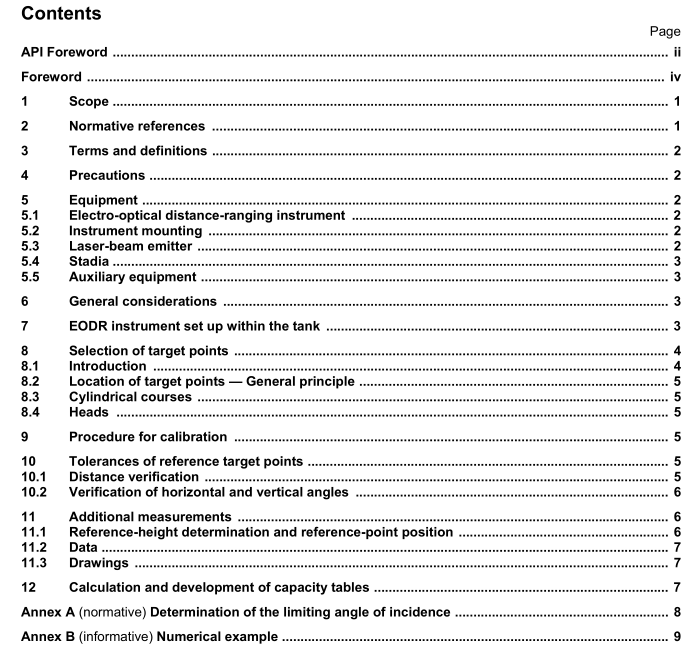API MPMS 2.2F pdf download

API MPMS 2.2F pdf download Petroleum and Liquid Petroleum Products—Calibration of Horizontal Cylindrical Tanks Part 2: Internal Electro-optical Distance-ranging Method ANSI/API MPMS Chapter 2.2F First Edition, April 2004 ISO 12917-2, Petroleum and liquid petroleum Products—Calibration of horizontal cylindrical tanks, Part 2: Internal Electro-optical Distance-ranging Method
8.2Location of target points -General principle
Target points shall be located on each surface, randomly but distributed over the entire surface.No target pointsshall be positioned within 300 mm of a welded seam or stiffener.
NOTElt is not a requirement of this method that any particular point be used as a target point8.3cylindrical courses
A minimum of 16 target points per course in tanks of diameter less than 3 m, and a minimum of 24 target points percourse in tanks of diameter 3 m or greater, shall be sighted.The uncertainty of calibration will be reduced if thenumber of target points is greater than the minimum specified.
8.4 Heads
8.4.1Flat end, elliptical, spherical head, conical head
A minimum of 50 target points, randomly but evenly distributed over the surface, shall be sighted.The uncertaintyof the calibration will be reduced if a greater number of target points is used.
8.4.2Knuckle-dished end (head)
A minimum of 16 target points, randomly but evenly distributed over the surface, shall be sighted. The uncertaintyof the calibration will be reduced if a greater number of target points is used.
9Procedure for calibration
9.1 Measure and record the horizontal angle, the vertical angle and the slope distance to each reference targetpoint. Two successive readings, at each point,shall be taken and they shall agree within the tolerance given inclause 10.Compute and record the average angles and distance to each point.
9.2Measure the horizontal and vertical angles and the slope distance to each target point on a surface.SeeFigure 2.
9.3lf more than one measurement station is required,move the instrument from station to station,takingsufficient measurements at each station to ensure a proper traverse.
9.4 After all measurements from one measurement station are completed,repeat the measurements to thereference target points.
9.5lf the repeated horizontal and vertical angles and slope distances to each reference target point do not agreewith the measurements taken in 9.1,within the tolerances given in clause 10, determine the reasons for suchdisagreement, eliminate the cause and repeat the calibration procedure.
9.6Commence measurements at one head and progress through the tank to the other head.9.7Carry out all measurements without interruption.
10 Tolerances of reference target points10.1 Distance verification
From each measurement station, the slope distance to each reference target point at the beginning and end of thecalibration shall be within± 2 mm.
0.2 Verification of horizontal and vertical angles From each measurement station, the horizontal and vertical angles to each reference target point at the beginning and end of the calibration shall be within ± 0,010 gon.
11 Additional measurements
11.1 Reference-height determination and reference-point position The overall height of the reference point at each dip-hatch (upper reference point), if fitted, above the dip-point shall be measured using a dip tape and weight, as specified in ISO 7507-1. This overall height, to the nearest millimetre, shall be recorded in the calibration certificate and permanently marked on the tank adjacent to that dip-hatch.
11.2 Data
The following data shall be determined and processed:
a) the operating temperature of the liquid to be stored in the tank;
b) the operating pressure of the tank;
c) safe filling height and maximum filling height;
d) deadwood.
11.3 Drawings
If tank construction drawings are available, calibration measurements shall be compared with the corresponding dimensions shown in these drawings. Any measurements which show significant discrepancies shall be checked.
If the calibration and drawing measurements do not agree, the reasons for the discrepancy shall be determined and the calibration procedure repeated, if necessary.
12 Calculation and development of capacity tables
12.1 Compute the data which describe, in mathematical terms, each surface. Ensure that the various sets of data for each surface are coherent and describe the tank. (see ISO 7507-4:1995, annex B).









